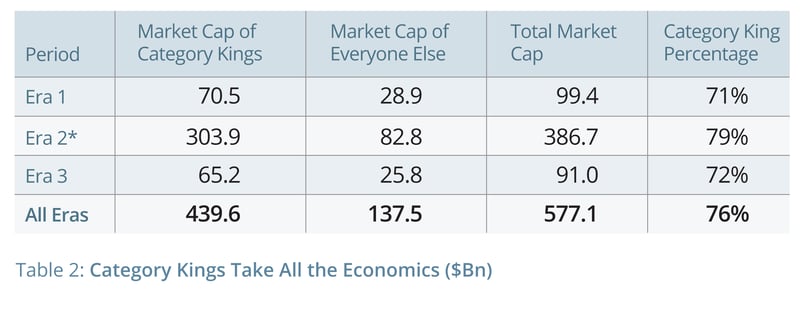TTMC // Time to Market Cap Report
A Category Design Research Report by Al Ramadan, Christopher Lochhead, Dave Peterson & Kevin Maney
Play Bigger Advisors, LLC.
THE NEW METRIC THAT MATTERS
- Executive Summary
- Where’s the Data Lebowski?
- Accelerating Time to Market Cap
- Consumer Enterprise
- Category Kings Take All the Economics
- Category Kings and Billion Dollar Kingdoms
- Play Bigger Pirate Index
- Play Bigger Insights for Executives and Investors
- Appendix A: Data Sources, Definitions and Methodology
With special thanks to:
Will Harvey and Lucas Ramadan, recent graduates from Stanford University and Whitman College.
Thanks for the enthusiasm, Python hacking and data science. Our favorite VCs, Investment bankers, CEOs and entrepreneurs who took the time to read,discuss and debate our findings.
1. Executive Summary
Speed as a competitive weapon has always mattered. Entrepreneurs, CEOs and venture capitalists(VCs) have been focused on speed-based strategies like “time to market” and “first mover advantage” for decades.
A new dimension of speed has emerged called Time to Market Cap (TTMC). TTMC is the measure of the time it takes a company to reach certain market capitalization milestones such as $500 million, $1 billion, or $5 billion. Time is measured by the number of years since the company wasfounded. Market cap is measured by (a) a company public market capitalization, or (b) a company valuation at the time of purchase, or (c) the most recent post-money valuation from a round of financing.
Based on extensive research and analysis, Play Bigger has learned that the speed of market cap growth for technology companies has almost tripled since 2000. Simply stated, winners aremeasurably winning faster.
They are reaching market cap milestones at almost triple the rate of predecessors from just over a decade ago. At the same time, losers are losing more quickly thanever. This has been a widespread gut feeling in technology circles, but now it is provably true, with a number of surprising ramifications.
By looking at companies through the TTMC lens, we can discover seminal trends in technologystart-ups. Specifically, we can see how quickly Category Kings, the companies that dominate the rest of their competitors in a particular market, rise above the rest.
Think Facebook, Twitter, Uber, Airbnb, Workday. Category Kings take a greater percentage of acategory’s total market cap now than in any previous era. Most Category Kings win 76 percent of the category’s valuation. And they snap up that big chunk of a category’s valuation faster than ever. TheTTMC metric is a barometer of just how quickly companies rise to dominance.
This faster TTMC reflects the new environment of ubiquitous social networks and always-on communication, plus a number of other key factors in the technology universe. We’ll discuss these forces later in this report.
TTMC has accelerated most dramatically for consumer-oriented companies, which is a reflectionof how quickly consumers today adopt new products and services. TTMC for enterprise technology companies also accelerated, but the longer buying cycles keep adoption, and thus valuation, from accelerating at the same high speed as consumer companies.
Play Bigger is a category design firm that specializes in helping companies define, develop anddominate market categories. We are working with a set of emerging Category Kings as well as helping new companies with their category design strategy. Our goal is to increase the odds of winning for technology companies. We embarked upon our TTMC research as a way to gain insight into the high speed required today to become market leaders and, eventually, Category Kings.
The results surprised us in a few ways. The time to success has accelerated considerably morethan we expected. In some categories, we have seen the TTMC accelerate by almost three timescompared to companies from just over a decade ago.
The implications for new technology businesses today are material. The shrinking window of time to win a category battle has an impact on company and investment strategy. This includes the race to find product/market fit and company/category fit, as well as the style and aggressiveness of execution, the type of people hired, and the speed required to condition a market to accept and consume new technology. The runway is shorter and the imperative to win faster has never been more important.
In this new world, there is no time for a company to begin in a wrong direction and little time to pivot. That’s a big change from past generations of start-ups.
Play Bigger’s research team combed through dozens of databases and information sources to gather valuation data on tens of thousands of companies, identifying venture-backed companies where both financing date and either public or private valuation events were available. Much of the private-investment information was either unavailable or difficult to obtain only a few years ago, so this kind of research was nearly impossible until recently.
KEY FINDINGS
- TTMC has accelerated for VC backed companies in the 2009-2013 era compared to companies in the 2000-2003 TTMC to reach $1 billion has accelerated to 2.9 years from8.5 years - a three fold increase in speed. (See Table 1, Page 7)
- VC backed companies from the current generation are growing their market caps at a rate of more than $350 million per year compared to the 2000 era companies who grew at about$130 million per (See Figure 1, Page 9)
- TTMC is accelerating much faster for VC backed consumer companies than for VC backed enterprise companies. A typical venture backed consumer company is growing their market cap at more than $600 million per year compared to a typical venture backed enterprise company that is growing their market cap at $100 million per (See Figure 2, Page 11)
- At the time of this report, 35 Category Kings dominate the valuation of venture backedtechnology companies founded since These companies are more valuable than all the other companies combined and have taken more than 70 percent of the total available market cap of any category or era since 2000. (See Figure 3, Page 13 andTable 2, Page 14)
- At the time of this report, there are 83 U.S. based venture backed companies founded since 2000 that have reached the $1 billion threshold. Almost half of them, and the largestcompanies, are Category (See Figure 4, Page 16)
- With a few notable exceptions (WhatsApp, Nest and Exact Target), at the time of this report, most Category Kings have remained independent companies. The report also shows the number and cumulative value of companies that have been acquired; many of the acquirers were Category Kings from eras before 2000 (Google/Waze, Microsoft/Yammer, Facebook/Instagram, Adobe/Neolane). (See Figure 6, Page 18)
2. Where’s the Data Lebowski?
This first step of our journey to move from assumptions to a fact-based discussion took much more work than we expected. We assembled a team of computer scientists, data scientists and business executives to comb through a variety of data sources (see Appendix A) to create a fact-based database.
The data on valuations and market cap are new and unstable. It took considerable time to weedout the false positives to get the accurate raw data to conduct our analysis. We literally had to walk through every transaction and make a ‘keep or discard’ decision.
We engaged with a long list of financial data providers. Some said they had the data, but itturned out they did not have anything. Others had APIs that were built in the NixonAdministration. Others had nothing more than a mailing list.
In the end we assembled data and trolled through:
508,628 private companies
18,430 private investors
52,055 private M&A deals
51,889 VC funding rounds
We restricted the study to venture capital backed U.S. companies in the technology space that were founded since 2000.
We examined financial transactions looking for VC funding rounds, M&A activity and IPOs where a value could be reliably established.
We selected transactions where a valuation was associated with the transaction. For example, Facebook Series B (MeriTech Capital, Accel Partners, Peter Thiel, Greylock Partners); Total Funding: $27,500,500; Valuation: $525,000,000.
We excluded debt financing, exotic financing, spin-outs, leveraged buyouts and other non-equity financings.
We excluded M&A transactions where the aggregate value was less than $30 million.
There has been a lot written about the methods of establishing the value of a private company(see Appendix A). Our attitude is that if the valuation was reliable we included it and if it was not valuable, we did not include it.
While we understand that valuations based on private investments have a different risk profile than publicly traded companies, we did not adjust the private valuations. We did not adjust for inflation.
We separated companies into three distinct time eras based on the year the company was founded.
Era 1: 2000 – 2003
Era 2: 2004 – 2008
Era 3: 2009 – 2013
No cohort selection is perfect but we tried to find a segmentation that fit with the financial cycles prevalent at the time.
We then developed TTMC Models for each era and the overall dataset.
When we first plotted market cap vs. years since founding, we found distinct patterns, showingthat companies in each era were reaching a particular market cap in a shorter period of time; that is TTMC was speeding up.
We completed a number of revisions of the model and database. Facebook is such an outlier that it required us to think in logarithmic scales, which is not always natural. But we quickly found that by representing the data in this way, it actually gave us better visual fidelity.
Once we had our model, we started applying it to different subsets. TTMC Consumer vs.Enterprise. TTMC by State. TTMC by Investor. Every time we applied the model to a particular subset, we uncovered new insights and ways of thinking about companies and their growth trajectories.
In one of our slicing-and-dicing moments, we uncovered what we believe is the “smoking gun” that proves the dominant effect of Category Kings. Not only had Time to Market Cap accelerated dramatically since the turn of the century, but a small set of companies, these Category Kings,took all the economics. Some of our favorite VC friends had been saying for years that the leader in a space is more valuable than all the other companies combined. But now we had the data to prove it.
Our research shows that 35 companies, all easily identified as Category Kings in their market spaces, have taken more than 70 percent of the total available market cap of any category or era since 2000.
3. The Accelerating Time to Market Cap
In our models, we divided the dataset into the three eras to see if the pace had changed over time. See Table 1. We weresurprised by how much it changed. Play Bigger analysis found that a typical company from Era 3 reached the $500 million market cap milestone almost three times as fast as the typical company from Era 1. See Figure 1.
|
MCAP Milestone |
Era 1 (2000-2003) |
Era 2 (2004-2008) |
Era 3 (2009-2013) |
Era 3 to Era 1 speed ratio |
|
$500 M |
4.5 |
2.3 |
1.6 |
2.8 |
|
$1 Bn |
8.5 |
3.5 |
2.9 |
3.0 |
|
$3 Bn |
24.6 |
8.3 |
7.9 |
3.1 |
|
$5 Bn |
n/a |
13.1 |
13.0 |
3.1 |
Table 1: The Accelerating Time To Market Cap
Shows the number of years it takes the "typical" company to reach certain MCAP milestones byEra. Era 3 is reaching TTMC milestones between 2.8 and 3.1 times as fast as Era 1
We have some understanding about why this is happening, with input from some of the leading investors and CEOs in Silicon Valley. Our short list of the key factors driving the accelerating Time To Market Cap include:
- New products and services get discovered and adopted at a speed never seen before, driven by the networked economy and always-on rich communication. Facebook wascreated in 2004; Twitter in Sites such as Tumblr, Pinterest, WhatsApp and overseasnetworks like Sina Weibo in China add to the dynamic.
- The iPhone, launched in 2007, ignited a smart phone revolution, and now five billion people carry a connected device. Distribution is cheap and global at the same time.
- Because of the fast spread of information, technology users come to understand that a problem(bad taxi service) can be solved with a new service (Uber). This creates a new category in consumers’ minds, while word quickly spreads about the leader who can address that category.
- Business models have evolved from perpetual licenses to subscriptions. This has reduced the barrier of entry for users and buyers dramatically. As a result, adoption happens faster. Freemium models only drive the adoption curves even faster.
- Services such as Amazon’s hosted web services have fundamentally changed the way companies create and deliver software applications. Start-ups no longer have to buy hardware or build data centers. The day Agile software development delivers a finished build, the product or service can go live to the world. That wasn’t true in the earliest part of this century. So fully-formed products and services can be globally launched and scaled faster than ever.
- The cost of distribution has reduced dramatically, thanks to networks and the cloud. That’s contributed to an overall reduction in the capital requirements of start-ups. This means there is more capital available on a proportional basis.
- CEOs have many more vehicles by which they can get funding well beyond the traditionalventure capital circles, including super angels, angels, crowd funding, and accelerators. As more money from more sources has become available, start-ups have invested big and fast to define and develop a category as quickly as possible.
- The emergence of the mega-round financing from crossover and hedge funds has created an abundance of available capital in the late stage market and enabled companies to delay their IPOs and continue to grow as private companies.
It would be easy to dismiss these fundamental drivers of business velocity and conclude that thisreport has simply chronicled another technology bubble.
We believe that our data about TTMC and Category Kings actually leads to the conclusion that we’re not in a bubble, but are in a time of shifting dynamics where more money flows to a few winners more quickly, and away from losers equally as quickly.
In all, while we see huge amounts of value being created, huge amounts are being destroyed, all at the same time. The industry looks like it’s in a bubble if you look at the money being pumped into companies early or at the value of Category Kings. The totality of the technology universelooks less like a bubble and more like an increasingly high stakes winner-take-all poker game.
Figure 1: The Accelerating Time To Market Cap
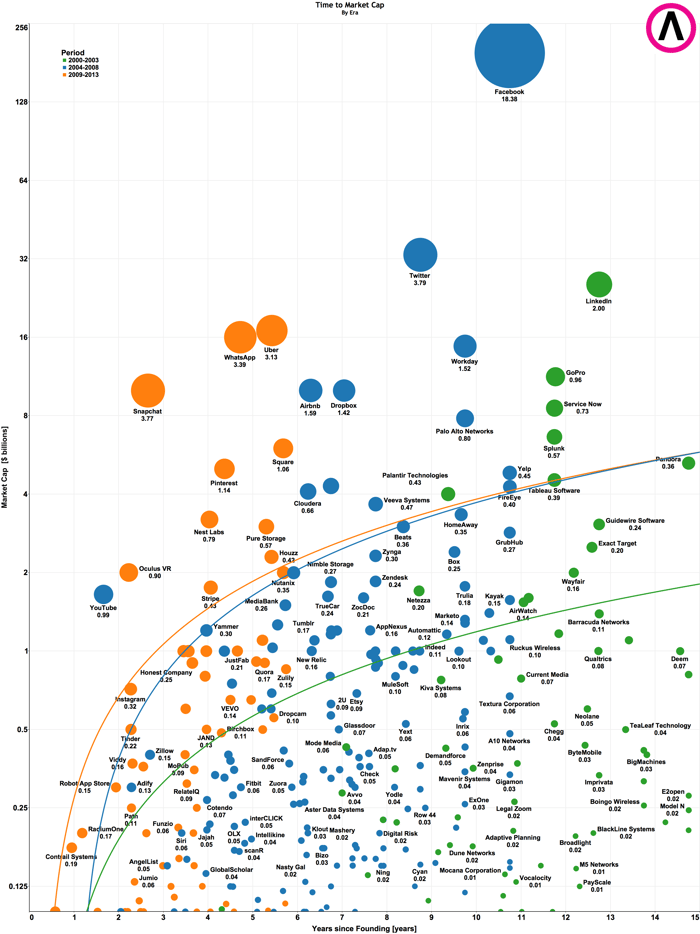
Individual dots represent the latest valuation of a company in the Market Cap/Time matrix. The size of the dot represents the MCAP Growth Rate of the company. The number under the company name is the MCAP Growth Rate in $ Billions / year. The yellow, blue and green lines areTTMC Models for a “typical” company from each era. The rising trajectories of these TTMC Modellines indicate a faster TTMC for each era.
4. Consumer vs. Enterprise
All the discussion about accelerating TTMC invited another question: Is there a difference in TTMC by category of company?
We classified companies in our study as either consumer (B2C) or enterprise (B2B). If a company has a mixed business model, we classified it as enterprise.
We found that consumer companies had a much faster TTMC than enterprise companies by a wide margin. See Figure 2.
By breaking out consumer and enterprise companies, we also sought to answer the question ofwhether the faster TTMC of consumer companies was skewing the whole pool of companies, and making it seem like enterprise companies were experiencing the same dynamic when they weren’t.
However, when we pulled out enterprise companies, we were surprised to see exactly the same phenomenon, though stretched over longer time periods. So within the enterprise group, while not as fast as for consumer, were enterprise companies where TTMC was still accelerating, with enterprise companies reaching $500 million almost twice as fast for Era 3 compared with Era 1.See Figure 2a.
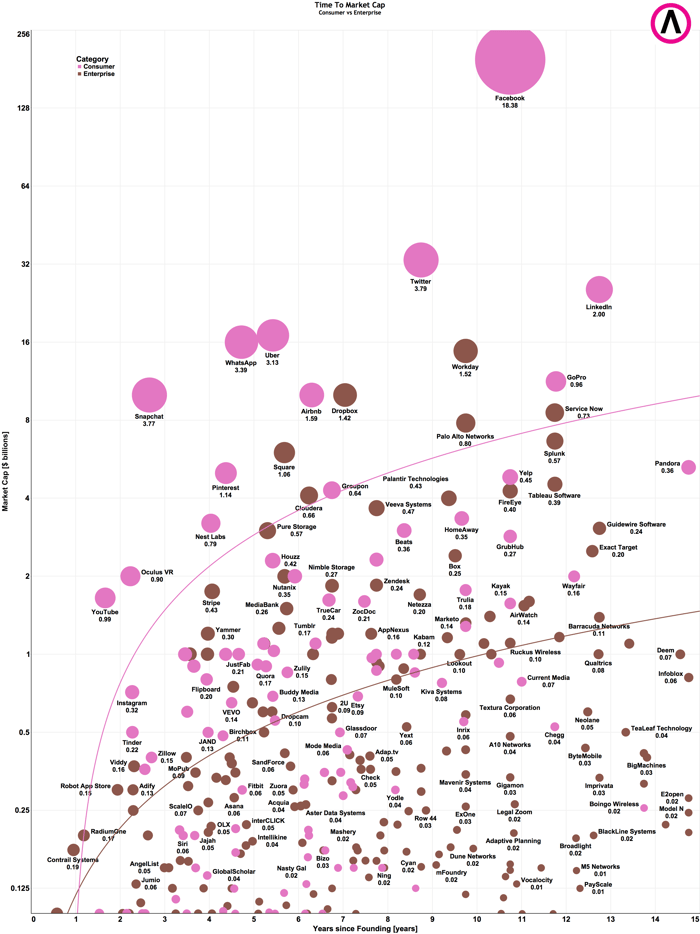
Figure 2: Consumer Companies Have a Faster TTMC than Enterprise Companies.
Individual dots represent the latest valuation of a company in the Market Cap/Time Matrix. The size of the dot represents the MCAP Growth Rate of the company. The number under thecompany name is the MCAP Growth Rate in $ Billions / year. The pink line is a TTMC Model for a“typical” consumer company and the brown line is a TTMC Model for a “typical” enterprise company. The higher trajectory of pink line indicates a faster TTMC for consumer companies.
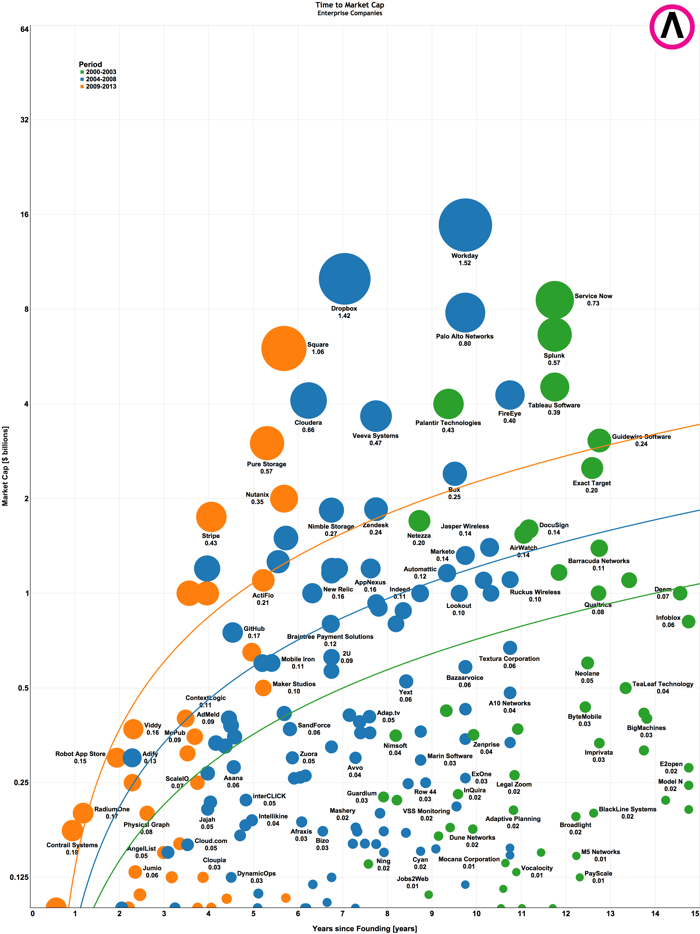
Figure 2a: Time to Market Cap has Accelerated for Enterprise Companies
Individual dots represent the latest valuation of a company in the Market Cap/Time matrix. The size of the dot represents the MCAP Growth Rate of the company. The number under the company name is the MCAP Growth Rate in $ Billions / year. The yellow, blue and green linesare TTMC Models for a “typical” enterprise company from each era. The rising trajectories ofthese TTMC Model lines indicate a faster TTMC for each era.
5. Category Kings Take All the Economics
Among all the companies in our study, we identified 35 companies that dominate the rest of their competitors in a particular market. We call these companies Category Kings.
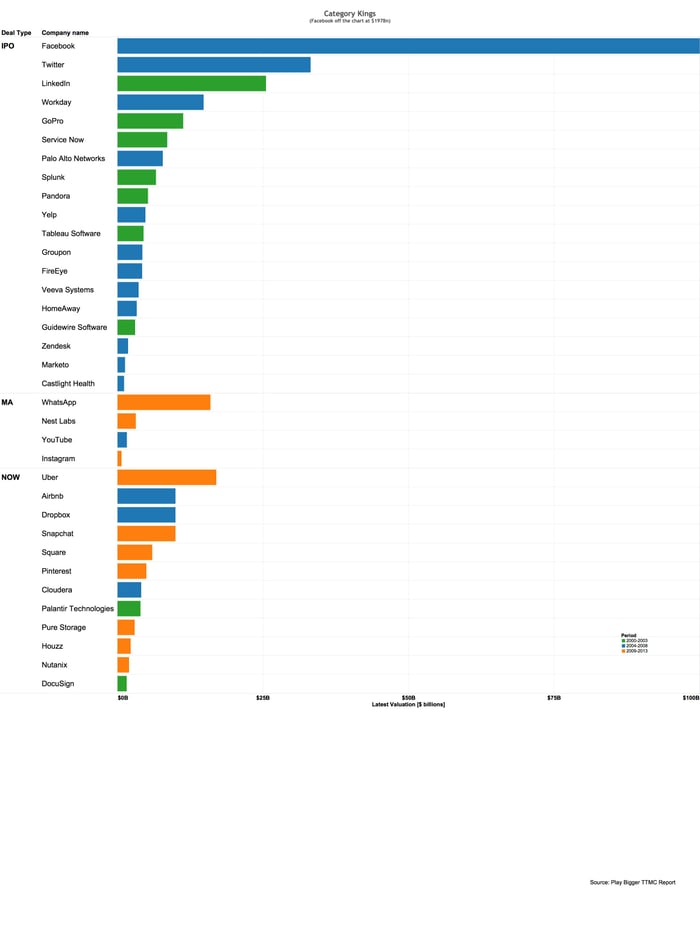 Figure 3: The Category King List
Figure 3: The Category King List
The Companies are shown with their current valuation. We broke them down into companies that have gone public (IPO), companies that were acquired (MA), and companies that are still private (NOW).
We selected these companies based on foundational category design principals:
- Category Potential – the number of people or enterprises that would be positively impacted by the company’s product or service and how much the market expands if the company’s future vision happens.
- Category Outcome – how well the company uses its Point of View to define the categoryproblem, how its solution solves that problem, and why the target audience for thatcompany should
- Category Appform – how well the company has built and architected its products and offers in a manner that would allow it to deliver the leading applications and platform for a category. The architecture must scale with explosive growth as the company rapidly expands its market.
- Category Blueprint – how well the company has articulated its vision for its solution and offersincluding current products, betas, and Also, how well the company depicts a future state and defines the entire solution that customers will demand from the leading company in the category.
- Category Ecosystem – the size and virility of the third party developer community who arebuilding applications, solutions and services on and around the company’s
As we sliced the data this way, it became obvious that one company, a Category King, takes all the economics in a particular category, leaving scraps of market value for the lesser competitors in that space. It also became clear that Category Kings are dominating the entire technology industry, since Category Kings as a group are capturing around 76 percent of the total value of all companies that met our study’s criteria, which is almost all VC funded companies since 2000. See Table 2.
|
Period |
Market Cap ofCategory Kings |
Market Cap of EveryoneElse |
Total Market Cap |
Category King Percentage |
|
Era 1 |
70.5 |
28.9 |
99.4 |
71% |
|
Era 2* |
303.9 |
82.8 |
386.7 |
79% |
|
Era 3 |
65.2 |
25.8 |
91.0 |
72% |
|
All Eras |
439.6 |
137.5 |
577.1 |
76% |
Table 2: Category Kings Take All the Economics ($Bn)
Category Kings take more than 70 percent of the Market Cap. By Era and overall.
* Facebook skews the Era 2 data due to their “outsized” MCAP.
We had a reason to sort the data for Category Kings. We have believed for years that the most successful start-ups become Category Kings and bury the competition. Many of the best and brightest VCs, investors and entrepreneurs had come to believe this too.
The industry has been able to cite anecdotal proof by pointing to great Category Kings such assalesforce.com and Uber. But no one had data-driven empirical proof, mostly, we suspect, because the underlying data was never there to analyze. Now, greater transparency in private fundings in recent years has given us the data. It just took someone like us to pull it together and look at it this way.
A common phrase in technology, ‘There’s room in this market for several players’ seems to be utterly false. The data shows that there’s room in any well-defined category for one super successful player and a bunch of companies that wind up as category serfs, and those that just die.
A few Category Kings get acquired, like WhatsApp and Nest, but most stay independent and quickly become too large to acquire. Most acquisitions are an incumbent company buying a category serf to try to get in the game. Almost all of those acquisitions go for less than $1 billion, and represent less than 5 percent of the aggregate value of the Category Kings.
Category Kings are more valuable than all the other companies in our study combined. They see MCAP Growth Rate of almost $1.6 billion per year and often reach a market cap of $5 billion in a few years. Many reach $10 billion in just under seven years.
As Time To Market Cap speeds up, the data shows winners win faster than ever, which means that losers lose faster than ever. With this increase in TTMC, categories get sorted out in a couple of years and there is very little time to pivot, especially in consumer technology.
We define losing as the moment where a company loses its ability to become the Category King as defined by flattened or shrinking valuations or market cap and slowed growth.
If a company has a market cap of less than $500 million and has been operating for more than six years, the likelihood that they become a Category King is very low.
6. Category Kings and Billion Dollar Kingdoms
We found 83 companies with a valuation of $1 billion or more. Almost half of these companies, and all of the largest billion dollar kingdoms, are Category Kings.
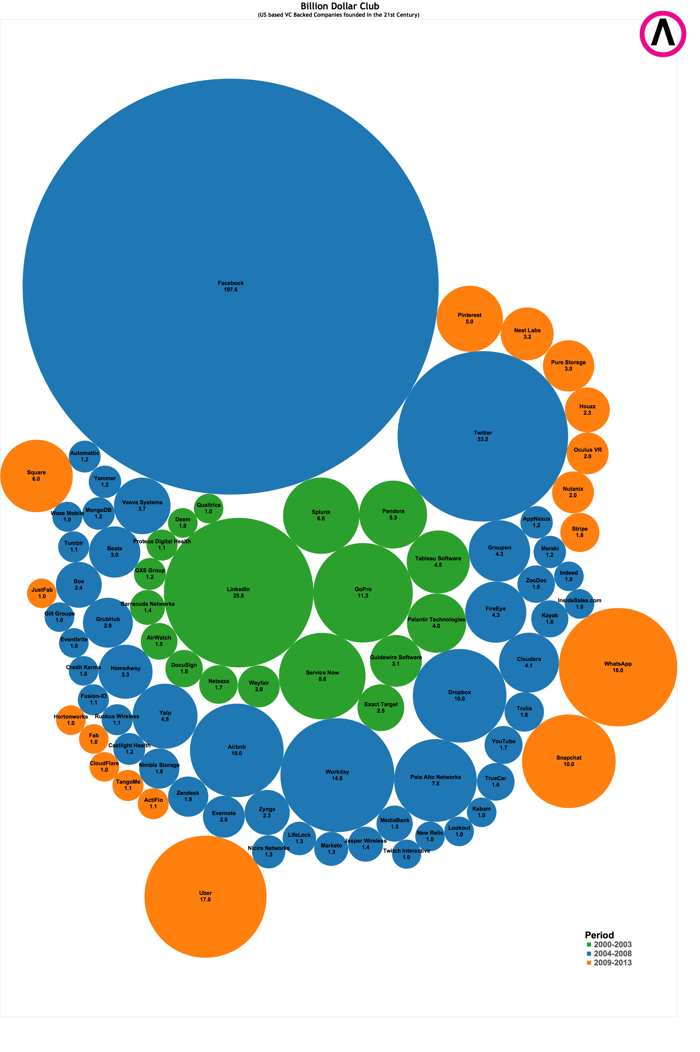 Figure 4: The Play Bigger Billion Dollar Club of 2014
Figure 4: The Play Bigger Billion Dollar Club of 2014
7. Play Bigger Pirate Index
(The Wanna-Be Category Kings Who Got Bought)
At Play Bigger, we celebrate pirates, dreamers and innovators. So we couldn’t help ourselves. Wecreated a Pirate Index to celebrate the greatest pirates who didn’t stay independent, but still made a huge impact. In this context, we define a pirate as a founder who builds and then sells his or her company.
The Pirate Index is calculated by dividing the valuation by the number of years since founding. The outsized winner might not be surprising, but take a look at the rest.
Four companies created more than $500 million in market cap per year of operation with one company (WhatsApp) experiencing MCAP Growth Rate of more than $3 billion per year of operation.
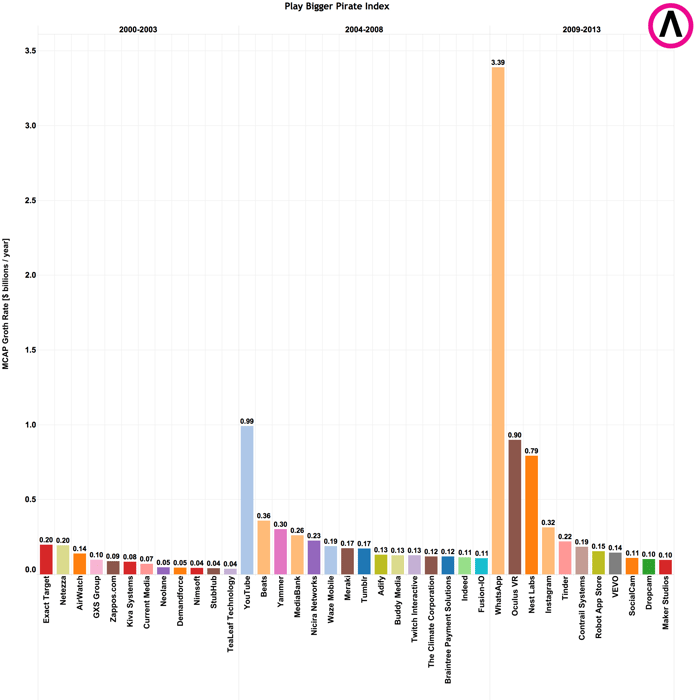
Figure 5: Pirate Index
A list of the top companies who were acquired ranked by the value they were acquired for divided by the number of years they have been in business.
We were also interested in who acquired these companies and it was no surprise to find that the Category King companies were the leading acquirers. We believe that Category Kingsexpand their Category Potential by making M&A moves into adjacent markets or acquiring core technology to expand their Category Blueprint.
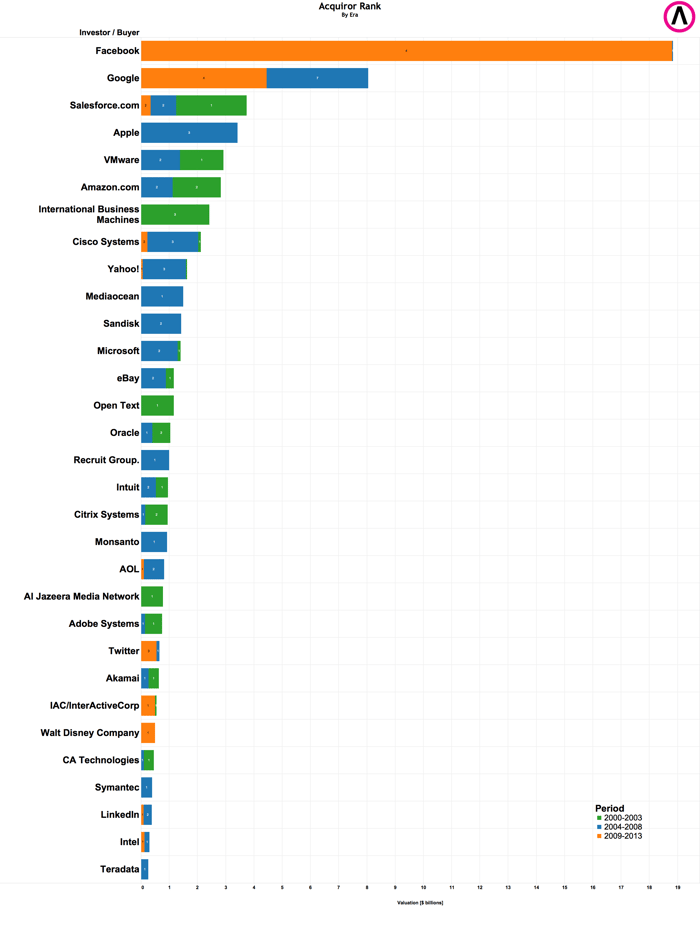 Figure 6: Category Kings Do All the Buying
Figure 6: Category Kings Do All the Buying
A list of the leading acquiring companies ranked by cumulative acquisition value of the companies they acquired.
8. Play Bigger Insights for Executives and Investors
Play Bigger believes that the tripling pace of TTMC over the past 15 years has profound implications for entrepreneurs, executives and investors in the technology industry.
It’s Good To Be Category King
With Category Kings taking more than 70 percent of the total available market cap in their space,there is little room for the number two, three or four player. It is no longer good business to be a me-too also ran or earn a participation ribbon for third place and beyond.
Little Time to Pivot: $500 Million In Under Six Years, Or Bye-Bye
Today, a six-year-old start-up with less than a $500 million dollar valuation or market cap will most likely never be a Category King or achieve a $1 billion valuation. We believe that means that there is little room for execution mistakes and little time left to pivot, particularly after the category has begun to take off.
Category Potential Is An Important Driver of TTMC
It is clear that savvy technology investors seek potential, not performance. Elite investors know that there is no such thing as a legendary company in a crappy category. They look forcompanies that can design a new category that develops into a large and growing total addressable market (TAM).
“Market Pull” Creates Coronations
Emerging Category Kings define a new space by conditioning the market to buy and consumenew technology in a new way. They design a new category, with the intention of creating massive market pull.
Think about what Netflix did to Blockbuster. Or what salesforce.com did to Siebel. In both cases they changed the rules of competition in a way that permanently disabled the incumbents by creating a “from – to.” Wannabe Category Kings do not attack incumbents head-on with “better”technology. They create a change in the buying and use-case criteria of a market with a “different” approach.
Category Design
Category Design is an emerging discipline in technology companies which focuses on company / category fit just as Product Design focuses on product / market fit. When done right, Category Design creates market pull (think lines out front of the Apple store or viral word of mouth for Uber) which becomes a major engine of growth.
Some of the great leaders in technology have practiced this art for many years. Remember when Amazon was just a “book” company? Compare the Category Potential today compared to back then. Category Design is likely to revolutionize company development in the same way that experience design revolutionized product development. Entrepreneurs and CEOswho are serious about becoming a Category King must hone their Category Design skills.
The Risks of an Accelerating TTMC
As we’ve discussed TTMC and its implications with leading VCs, investment bankers, CEOsand entrepreneurs, there are a clear set of risks and concerns that surface as TTMC continues to speed up.
- Category Kings have to be attentive and vigilant because of the rate of change of the “Big Platforms” powering the digital economy and the accelerating global adoption of technology such as smartphones. Start-ups can emerge out of nowhere to redefine categories and markets. Companies can turn from being a meteoric star to a has-been overnight. Companies have to continually expand Category Potential to thrive over time.
- Expectations have the potential to run away from reality for many investors and entrepreneurs. They all believe – as they should – that they will become a Category King and reach multi-billion dollar valuations. But Category Kings are rare. By definition, most companies will never be Category Kings.
- The rocketing valuations of Category Kings draws media attention to these man- agement teams, often distracting them or warping their view of reality. Egos begin to believe their ownhype and as a result they commit Category Neglect which has a devastating effect on market cap.
- The high-speed, high-investment race to become a Category King drives a great deal of stupid spending on marketing and sales in particular.
- When private investors drive valuations to levels higher than public markets are willing to bare, it can cause significant different between the IPO valuation and the enterprise valueand category Zynga and Groupon are great examples of companies who suffered from this phenomenon.
Appendix A: Data Sources, Definitions and Methodology
Data Sources
The goal of this research project was to understand how quickly venture backed technology companies market capitalization changed (grew) and whether there had been a change in the “Time To Market Cap” during different periods of history.
The key metric we needed to conduct this research was valuation.
There has been a lot written about the methods of establishing the value of a private company.
Private Company Valuation, by Aswath Damodaran, New York University
http://people.stern.nyu.edu/adamodar/pdfiles/eqnotes/pvt.pdf
Valuing Private Companies, by Investopedia Staff
http://www.investopedia.com/articles/fundamental-analysis/11/valuing-private-companies.asp
Private Company Valuation, by PrivCo
http://www.privco.com/knowledge-bank/private-company-valuation
Private Company Valuations & Valuation Multiples, by CB Insights
https://www.cbinsights.com/private-company-valuations-multiples
Up until recently private markets have been opaque at best. One minute you haven’t heard of a company, the next minute they are a billion dollar company taking over the world.
The good news is that the Venture Backed private technology company market is becoming more transparent. A new breed of companies have emerged to provide insights like never before. Many of these “private market transparency” companies are on their own quest for global domination. Here is our short list:
- CrunchBase
- PrivCo
- VentureDeal
- VC Experts
- Mass Investor
- Owler
- CB Insights
- Mattermark
- Dow Jones Venture Source
We contacted all of these providers (and more) and ran a detailed analysis on what they offer and the quality of their database and APIs.
We selected PrivCo as the primary source because of the depth of their valuation data. Getting reliable valuations, especially for private companies is tough. We supplemented their data with data from Crunchbase which has really improved in access and quality over the past year or so.We also used Google Finance, Bloomberg and numerous other news sources.
Definitions
We created a number of defined terms used throughout this report such as TTMC, TTMC Modeland MCAP Growth Rate. Here is how we define them:
- Market Cap is measure of a company’s valuation and is typically calculated by multiplying the number of shares outstanding by the current share price. In this report we establish a company’s market cap in one of three ways:
- Public market capitalization as reported by 3rd parties such as Bloomberg, Google finance, etc.
- Valuation at the time of purchase of the company by another entity; or
- The most recent post-money valuation from a financing
- Time is measured by calculating the difference between the date of a financial transaction or valuation and the date the company was founded. It is expressed in decimal years.
- TTMC it is a measure of the time it takes a company to reach certain market capitalization milestones such as $500 million, $1 billion or $5 billion.
- A TTMC Model describes the relationship between Market Cap and Time for a set of companies. Typically a TTMC Model is shown as a line or
- MCAP Growth Rate is a measure of the speed at which a company grows its market cap each For a single company it is calculated by dividing its latest Market Cap by Time. For a group of companies it is the first derivative of the TTMC model. Its units are $ billions/year.
Methodology
The research was conducted using a primary data source from PrivCo. The PrivCo team is obsessed with sourcing accurate, complete, and timely private company research and we take pride in finding the "hard-to-find.”
We also used Crunchbase. We wrote python code to extract data. We also downloaded data where APIs weren’t available.
We selected financial transactions from 500K+ companies where they met the following criteria:
- Headquartered in the United States
- Venture backed
- In the technology industry
- Founded since 2000
- Had a financial transaction where the valuation was (a) known and (b) in excess of
$30 million in the event of a M&A Transaction
This created a raw dataset of 4,531 transactions. We further reduced the transactions down to a final database of 974 transactions by removing duplicates, questionable valuations, non-standard VC transactions and non-technology companies.
We then added the public company data using a few sources including Google Finance and Bloomberg. We used the market capital valuation as of October 19, 2014.
We have a mix of public, M&A and private valuations in the model. We appreciate the difference in value based on liquidity but we didn’t discount any of the valuations based on risk or any other measure.
We did not adjust for inflation.
The materials contained herein are copyright property of Play Bigger Advisors, LLC. This content may not be reproduced or redistributed, in whole or in part, without the prior written consent of Play Bigger Advisors, LLC. This document does not constitute conveyance of any intellectual property rights. Play Bigger Advisors, has created materials, methodologies, and practices that are proprietary. All intellectual property associated with these works and any derivatives works are the property of Play Bigger Advisors, LLC.
No part of this document may be reproduced by any mechanical, photographic, or electronic process, or in any form of a phonographic recording, nor may it be stored in a retrieval system, transmitted, or otherwise copied for public or private use without written consent from Play Bigger Advisors, LLC.
This information is solely for informational purposes. Objects in mirror are closer than they appear. Batteries included. Donot use plastic bags as a children’s toy. Don’t text and drive. Skiing is a dangerous sport. Coffee is a hot beverage that will burn your crotch. In the event of a water landing, pray your airplane captain is “Sully” Sullenberger. Johnny Cash was right.
All products contain nuts.

